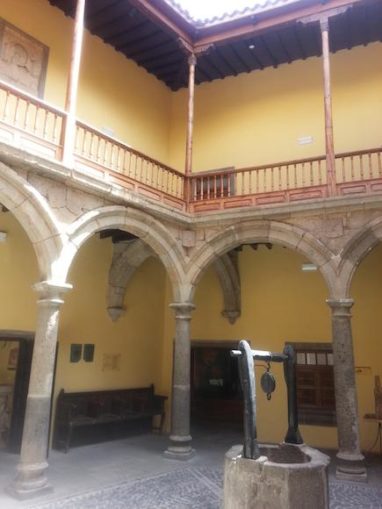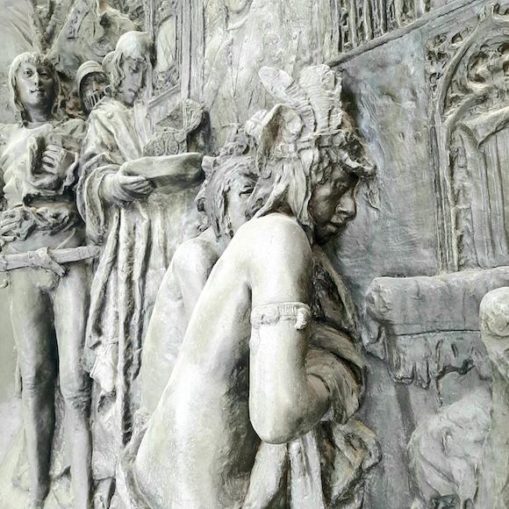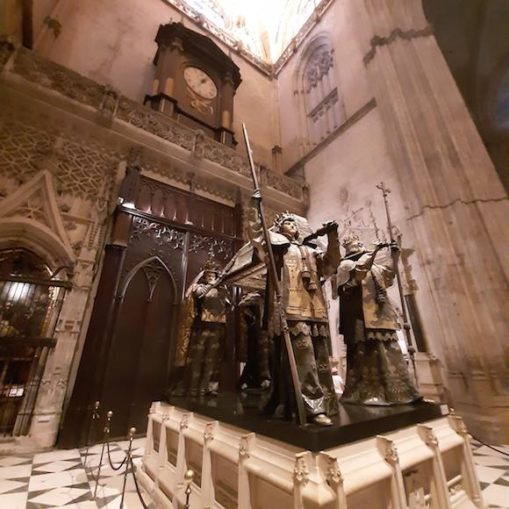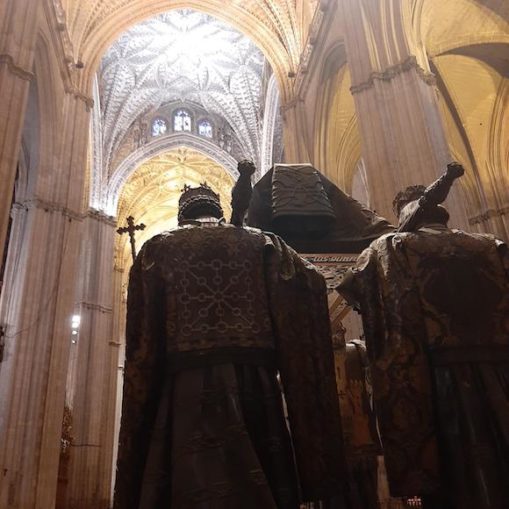There is no definitive date for the birth of Xpoual de Colon. It is believed he was born between August 26th and October 31st in 1451 in Genoa, although there are also claims that he was born in Savona, Sevilla or even Portugal. It is also said that he was the grandson of a converted Jew, on account that his father Domenico was a wool worker and merchant, which was a favourite occupation of those who took up the Christian faith to avoid persecution. This however cannot be corroborated. His mother was Susanna Fontanarossa who bore five children, the eldest being Xpoual followed by Giovanni, Bartholomew, Giacomo and her only daughter Bianchinetta. Susanna was born in the hillside village of Monticello on the Genoese Island of Corsica in 1435 and her wealthy Catholic family-owned substantial real estate in Quezzi in the Bisagno Valley which now forms part of Genoa.
By contrast Domenico did not have the advantage of a noble birth and at the age of eleven was apprenticed as a wool weaver before setting up as a merchant, a publican, a cheese maker and a wine importer. It is also noted, that although well-liked, Domenico was work-shy and in latter years relied almost totally on his sons for sustenance.
It would be strange in 15th Century Europe for a rich father to allow his daughter to marry a man from the low merchant class. With the disparity between August and October given for the date of birth, it would be reasonable to suggest that Xpoual was conceived out of wedlock and to save face the Fontanarossa family made sure the marriage was enforced in what today would be termed a “shotgun wedding.” Whatever the circumstances surrounding Xpouals birth it is testimony however to his extraordinary life that he is still remembered nearly 600 years later.
In Italy Xpoual Colón is also known as Christoforo Colombo, Christoual de Colón, Christovam de Colón and Christofferus de Colón. In Spain he is known as Cristobal Colón, while in the English-speaking world he is known as Christopher Columbus, the explorer, the scientist, the astrologer, the man who discovered America (which is totally untrue) and the man who carried Christianity to the world. He is also a man under fire from the Woke Brigade who will let nothing rest.
At school we were told that; “In fourteen hundred and ninety-two, Columbus sailed the ocean blue,” that he landed in America and to be honest the teachers left it at that before regaling us with tales of Henry VIII, Tudor England and the execution of Anne Boleyn.
Much of the early life of the de Colón family is shrouded in mystery but we do know that Xpoual and his brother Bartholomew began their early careers as cartographers for the Portuguese. From 1420 and the Age of Exploration the Lisbon Merchant Marine had used a fleet of small ships called caravels which were used to explore the coast of West Africa. It was soon established as a viable trade route dealing in spices, wood and slaves. While Bartholomew was content with being land-based, Xpoual was the adventurer who went out on the caravels to learn the intricacies of foreign trade. By 1477 Xpoual had also sailed to Iceland and Ireland with the Merchant Marine before taking a commission a year later to buy sugar in Madeira as an agent for the Genoese firm of Centurioni.
In 1479 he met and married Felipa Perestrello e Moniz who came from an impoverished Portuguese family of once great nobility. In 1480 they had a son, Diego and between 1482 and 1485 Xpoual traded with Guinea and the Gold Coasts of tropical West Africa. During this period and before 1484 he returned to Porto Santa to discover that his wife had died and after settling her estate he moved with his son to Castille where he took a 20-year-old orphan called Beatriz Enriquez de Arana as his mistress. It is likely that he was already acquainted with Beatriz when he was in Córdoba, which was a gathering place for Genoese merchants and where periodically the Catholic monarchs were located.
In July 1488 she bore him a son who was named Fernando in honour of the King of Aragon.
Xpoual had begun petitioning for support to create a western trade route across the Atlantic to the Spice Islands as early as 1484. He was denied by King John II of Portugal in 1486 and by Henry VII of England in the same year who deemed his plans as “nothing but fanciful folly.”
In 1486 he abandoned Portugal as his base and moved to Castille in Spain. It is thought that his decision was partly made because of his strong Catholic Faith and his wish that King Ferdinand and Queen Isabella would succeed in ridding Spain of the infidel who were being forcefully driven back to North Africa and the Middle East. On January 2nd 1492, Muhammad XII of Granada (King Boabdil) surrendered the Emirate of Granada, the city of Granada and the Alhambra Palace to the Crown of Spain thus ending over 700 years of Muslim rule.
Although Xpoual had previously petitioned both King Ferdinand and Queen Isabella (individually and together) there now followed one of those curious quirks of fate that seem to litter history. In 1491 Xpoual had spent some time with the Franciscan friars of La Rábida near Huelva. Also present was Juan Pérez de la Rábida who had just been designated as one of the few priests who could hear the confessions of Queen Isabella. At the same time Xpoual gained support from the newly appointed Treasurer of the United Spain, Luis de Santángel, who argued that the King and Queen should take advantage of their position and look for a policy that would expand not only trade but also the influence of Christianity in foreign lands at the detriment of the Portuguese.
Juan Pérez, Luis de Santángel and Xpoual were all present to watch the surrender of King Boabdil in Granada. Xpoual had set off to return to Rábida when he was bid to return for an audience with the king and queen. It was at this stage that they gave Xpoual the finance to attempt to reach the Indies by sailing west under what would eventually become the Capitulations of Santa Fe.
Losing no time Xpoual put together a fleet of three ships on the Tinto River and set up a consortia with a royal treasury official raising 1,140,000 Maravedis from Florentine and Genoese bankers. The balance on the total cost of 1,765,734 was met by the Spanish Crown and the voyage by today’s standards cost a total of £500,000.
The ships for the voyage were known by their nicknames of Niña, Pinta and Santa Maria, where the Santa Maria was officially La Gallega, the Niña was the Santa Clara while the Pinta’s real name remains unknown.
He left Palos de la Frontera with a combined crew of 90 men on August 3rd 1492 and headed to Gran Canaria.
The stopover at Las Palmas was for final supplies and repairs but also came with a fortuitous side. The Portuguese had attempted to sail in the general direction favoured by Xpoual but by attempting it from a higher latitude had always been driven back by the westerlies. By starting from the North West African coast Xpoual was able to circumvent the prevailing wind and make much better progress.
The house and hacienda used by Xpoual in Las Palmas is now a museum called the Casa de Colón. It has displays showing charts, ships and navigational aids from the 15th century along with a mock-up of the captain’s cabin on the Niña, which is less well-appointed than the average student’s “digs” of today. It is a very peaceful museum and the home for two parrots who have had their wings clipped but make a daily walk for freedom through the gift shop.

© Año Nuevo 2014, Going Postal
On the 33rd day out of Las Palmas land was sighted by Rodrigo de Triana and subsequently Xpoual came ashore at Guanahini which he named as San Salvador (now Watlings Island in the Bahamas.) At this stage the explorer was convinced he had circumvented the globe and was in the East Indies. Believing riches were now within his grasp he set off almost immediately to land in Cuba, which he mistakenly thought was Cipango (Japan) but finding the land was devoid of great cities he determined he must be on the Cathay mainland and went off in search of the fabled city of Zaiton, which is now Quanzhou in China.
On the first voyage, Xpoual also visited the Dominican Republic which he called Hispaniola, Haiti which he called La Navidad and Jamaica which he called Juana. There are also many places named by Xpoual that are still in use today. In fact it was Xpoual who coined the term Indios (Indians) for the indigenous population of the West Indies. He also brought back the “hammock” which was widely used in the Bahamas and henceforth has been popular with sailors.
Xpoual arrived back in Spain on the 15th March 1493. He was presented to the Catholic monarchs in Barcelona and gave a glowing report of what he had found, presenting gold, jewellery and pearls (looted from the Indios) while arranging to have Ferdinand and Isabella carried to court on a pair of palanquins borne by the Indios, who he had kidnapped from the Bahamas. He also presented his benefactors with parrots, exotic plants and the first peppers imported to Europe, while talking of what he had found and how the islands were ripe for the taking and how the inhabitants could most definitely be persuaded to take up Christianity to honour the king and queen. It was his crowning glory and by degree unfortunately marked the beginning of his downfall.

© Año Nuevo 2022, Going Postal
Perhaps Xpoual had overstated his achievements because his words immediately prompted the need for a second expedition on a much more grandiose scale. On September 25th he led an expedition of at least 17 ships from Cadiz, containing a substantial group of friars, over 200 private investors, 1,300 salaried men of the Crown and a troop of cavalry to suppress any insurrection. One can only surmise at the optimism involved of those heading to the Caribbean and the trepidation of Xpoual who might not have been able to “produce the goods” expected of him from the evidence he had presented.
In all Xpoual made three further voyages exploring the Lesser Antilles in 1493, Trinidad and the Northern Coast of South America in 1498 and the Eastern Coast of South America in 1502. As time went on however his relationship with the Crown of Castille and the colonial administrators became ever more strained, leading to his arrest and removal from Hispaniola in 1500 on the charge of significant brutality. There followed protracted litigation over the perquisites that he and his heirs claimed they were owed by the Crown and litigation brought against him by the family of the deceased Martin Pinzón, the captain of the Pinta who claimed that Xpoual had not been the first to reach the Bahamas and that he had cheated on monies owing.
There is no doubt however that Xpoual paved the way for the Conquistador Invasion of South America, which entailed the plundering of gold in huge quantities for the Crown and Church and the spread of Christianity throughout the whole of the southern continent. He was however not going to live long enough to have his expeditions recognised or to see further discoveries.
Xpoual de Colón died on May 20th, 1506 in Valladolid, Spain. He was 55 years old. The cause of death was given as heart failure caused by gout. For some time he had suffered from arthritis and “bleeding behind the eyes” leading medical historians to surmise that he had really died from Reiter’s syndrome, a reactive arthritis caused by bacterial intestinal infections and/or sexually transmitted diseases.
He was buried in Valladolid but it is reckoned that in death Xpoual travelled further than most people do in life. In 1509 he was moved to the family mausoleum at a monastery on La Cartuja, a river island near Sevilla. In 1542, in accordance with the will of his son Diego, Xpouals remains were transferred to Santo Domingo, Hispaniola which is now in the Dominican Republic. The delay in acquiescing to the wishes of father and son to be buried in the Americas was less to do with the obduracy of the Crown and more to do with the fact that there was not a suitable church of grandeur to house them. He laid, seemingly at rest, there until the Spanish ceded Hispaniola to the French in 1795 when he was again moved, this time to the Baroque splendour of Havana Cathedral. He was to pass a relatively peaceful time here, acquiring a new monument by the sculptor Arturo Melida before America declared war on Spain in 1898 and it was considered prudent to return his body to the cathedral in Sevilla, where he remains to this day, held aloft by four allegorical figures representing the old Spanish kingdoms of Castille, Aragon, Navara and Leon.
It is claimed that In 1887 workers in the Cathedral of Santa Domingo found a box labelled “Don Columbus, Admiral of the Ocean Sea.” In the box was a collection of bones and the Dominican Republic have asserted ever since that the wrong bones were transferred to Cuba.
On the 500th anniversary of Xpouals first voyage and egged on by the woke NBC the claim was asserted again to the world claiming that the real remains of Xpoual were still in the Dominican Republic, housed in a lighthouse museum. This prompted the Spanish to start extensive DNA testing on the bones of Xpoual, his brother Bartholomew and his son Diego. In 2006 they published their conclusions that they had the real Xpoual Colón and that he was buried in the Cathedral of Sevilla.

© Año Nuevo 2022, Going Postal
It is all so easy to denigrate Xpoual based on the standards of today, while not understanding the vagaries of the time in which he lived. It is all too easy to harangue him for slave trading while totally ignoring the fact that he was one of the first really great explorers who took a risk to open up the world and spread Christianity when the Muslim world had been prevalent for so long. Xpoual was not a mealy-mouthed liberal but a passionate Catholic and a man of vision who saw beyond the safety of opinion and questioned the world in which he lived.
It is said that his endeavours and principally those of the Conquistadors netted the Spanish exchequer a staggering 180 tons of gold and 16,000 tons of silver with a large amount coming from the Cerro de Petosi in modern-day Bolivia. The sad fact though is that Spain, having expelled 150,000 Jews had no one who could manage the vast sums of money they were importing, which led to them being reliant on European nations to run their finance, to the point that they only ever retained 5% of trade from Latin America. In short the Spanish owned the cow but in the end it was everyone else who got to drink the milk. Looking at the European Union and Spain today it is interesting to see that very little has changed in 600 years.

© Año Nuevo 2022, Going Postal
If you sit in the garden, swinging in a hammock, fag in hand looking at the greenhouse full of tomatoes and capsicums and are finding it hard to choose between the galaxy plain or milk chocolate…………….spare a thought for Xpoual Colón because without his vision you would have no hammock, no fag, no tomatoes, no capsicums and no chocolate.
R.I.P. XPOUAL COLÓN
© AÑO NUEVO 2022



